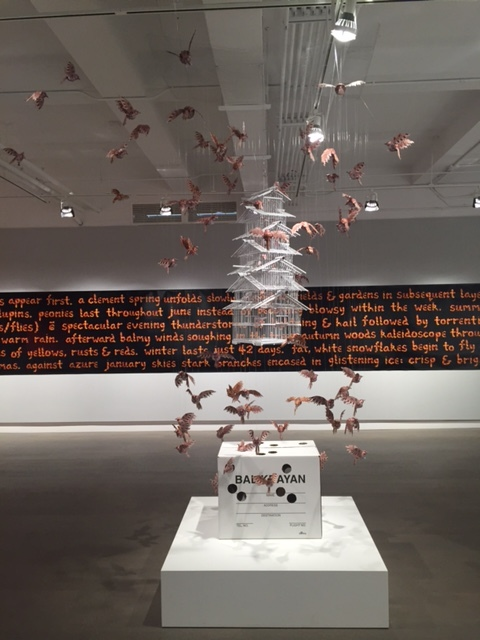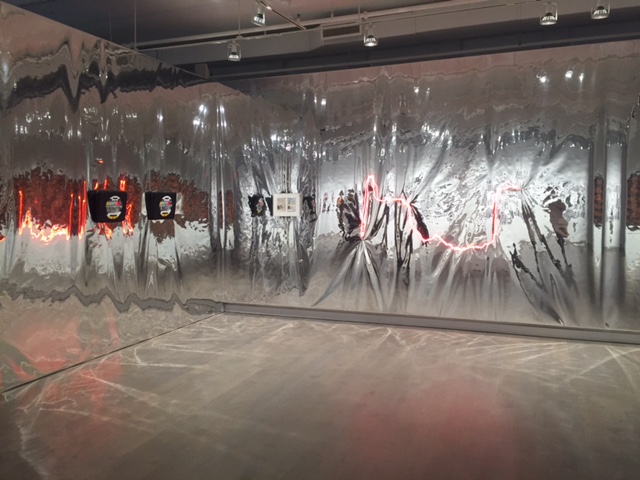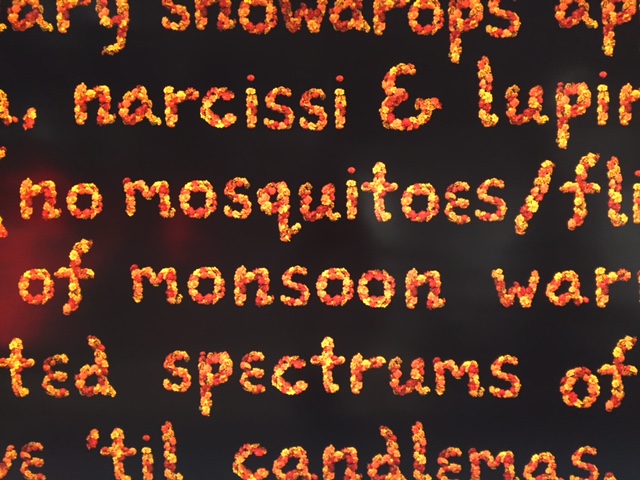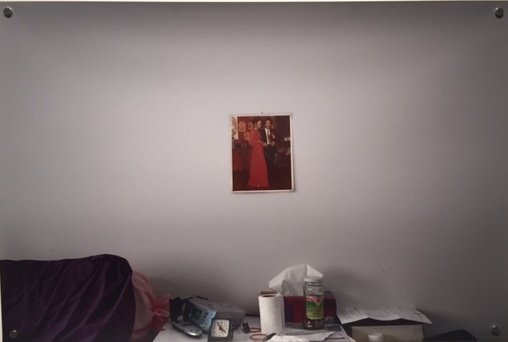In international cities driven by Capitalism, technological advancement, ease of global travel and high-speed wireless connectivity, cultural homogenization is synonymous with homesickness and anxiety. Each of the artists in the exhibition Yonder at Koffler Gallery confronts homelessness or homesickness in the immigrant experience or the struggle with identity faced with global anxiety. Larger installations, sculptures and video works are featured in the main gallery space, a sound installation crosses into the stairwell, photography series are featured on the upper floors of Artscape Yongplace and a flag flies in the sphere of public sculpture.
The works of Julius Poncelet Manapul and Brendan Fernandes in the main gallery express a very personal struggle with cultural and community integration. In Fernandes’ video Standing Leg (2014), he attempts to stand up with his foot in a wooden ballet foot stretcher. His reason for leaving dance as a profession was due to an injury, however, the video is meant to symbolize how his body – of Kenyan and Indian descent – could not physically conform to the posture of the medium. The foot stretcher may further be interpreted as a metaphor for the pain and violence of post-colonial adaptation, and the rigorous structure of Ballet’s aesthetic ideals. Ultimately, Fernandes is unable to stand on his leg as his foot will not conform to the shape of the prop – his is a personal struggle.
 Bredan Fernandes, Standing Leg, 2014, video still
Bredan Fernandes, Standing Leg, 2014, video still
Julius Poncelet Manapul’s sculpture Balikbayan Babia Maya (2016) is also wrought with symbolism for personal struggle deriving from the Filipino and immigrant communities. His piece begins on a short plinth where a white Balikbayan box – used to send care packages from the Filipines – is filled with cut offs and phalluses from pornographic online sources. Emerging from the box are sixty-nine castrated native birds with Manapul’s fingernails for talons made from the more figural pornographic images. Above the delicate birds, a birdcage is hung filled with twenty-six sexy butterflies, one for each year he emigrated. Among the complex, detailed innuendos is a personal crisis. As a gay man he might not feel a sense of belonging to a Catholic country, and as an Asian man, in the gay community he might be perceived as an object. The personal stories expressed in the works by Manapul and Fernandes only confirm that the multitudes of effects cultural homogenization can have are as diverse as the individuals in a global “melting pot.”
 Installation view with Julius Poncelet Manapul, Balikbayan Babia Maya, 2016 (in front)
Installation view with Julius Poncelet Manapul, Balikbayan Babia Maya, 2016 (in front)
The global scale of the cultural belonging to the homesick nomad takes the form of an installation in four parts by Jerome Havre. Poetics of Geopolitics (2016) has four clear stanzas. On the right side one red, jagged, neon light traces the oceanic fault line connecting South America to Africa, as a reminder that geological borders become political ones – it also reminds me of the abstract neon graphs by Theaster Gates. On the left side, two wooden sculptures of TV ‘set’ to the color test channel imply TV as a medium for defining ‘normalcy’. Using color as a mean to do so suggests that it vaguely defines racial ‘normalcy’. The third section is personal. Havre’s two active passports representing two active citizenship are framed. Passports are internationally recognized forms of personal identification, and as such they qualify individuality, but unfortunately they also enforced our identities, homes and futures as defined by political borders. Finally, a Mylar sheet is hung behind the other three pieces. It reflects the other works in the gallery and incorporates the visitor into the work. Like the Sainsbury Wing of the National Gallery in London is postmodern for fitting in by reflecting the surrounding architecture while incorporating a new medium. Mylar in Havre’s work is a technique of assimilation while also establishing the elements that compose the original installation.
 Jerome Havre, Poetics of Geopolitics, 2016
Jerome Havre, Poetics of Geopolitics, 2016
The artists in Yonder have each found a diverse medium to express personal experience, but there are also less political matters involved in the immigrant experience that are relatable to everyone, including weather and homesickness. Covering the length of the gallery’s back wall is Sarindar Dhaliwal’s chromira print, Weather: An Immigrant Perspective (2016). The print is part of a series titled The Cartographer’s Mistake formed by a custom-made marigold alphabet. The story of a fictional mapmaker who is punished and reincarnated as a migratory bird allows Sarindar to be nostalgic for the weather between Punjab and Bengal where the cartographer worked. The mosquitoes are romanticized and the monsoons preferable. As weather is a universal experience, it is easy to sympathize with this particular type of homesickness.
 Sarindar Dhaliwal, Weather, an Immigrant Perspective, 2016
Sarindar Dhaliwal, Weather, an Immigrant Perspective, 2016
On the third floor, photographer Esmond Lee captures most literally the emptiness of the homesick nomad in his series Between Us (2014-2015). Lee’s images depict the inside of the classic suburban home, with its empty rooms and white, unpainted walls on which unframed family pictures are tapped. The lack of bodies is palpable and the effects of the homeowners are of the least permanence, implying a sad discomfort. Anyone who has lived in more than one city will understand a constant homesickness for the place you are not in for a while, for the left behind family and friends who helped to shape your identity.
 Esmond Lee, Between us, 2014-2015
Esmond Lee, Between us, 2014-2015
Every artist in the exhibition expresses vulnerability about widely felt anxiety, each filled with pain or humor and each worth engaging with.
Text and photo: Alice Pelot
*Exhibition information: Yonder, a Group Exhibition / Sarindar Dhaliwal, Brendan Fernandes, Rafael Goldchain, Jerome Havre, Luis Jacob, Esmond Lee, Julius Poncelet Manapul, Sanaz and Mani Mazinani, Divya Mehra, Zinnia Naqui, Jose Luis Torres, 2fik, Blue Republic, Diana Yoo, Jinny Yu, Z’otz* Collective. Curated by Matthew Brower and Mona Filip, September 21 – November 27, 2016, Koffler Gallery, Artscape Youngplace, 180 Shaw Street. Gallery hours: Tues – Fri 12 – 6 pm, Sat & Sun 11 am – 5 pm.
